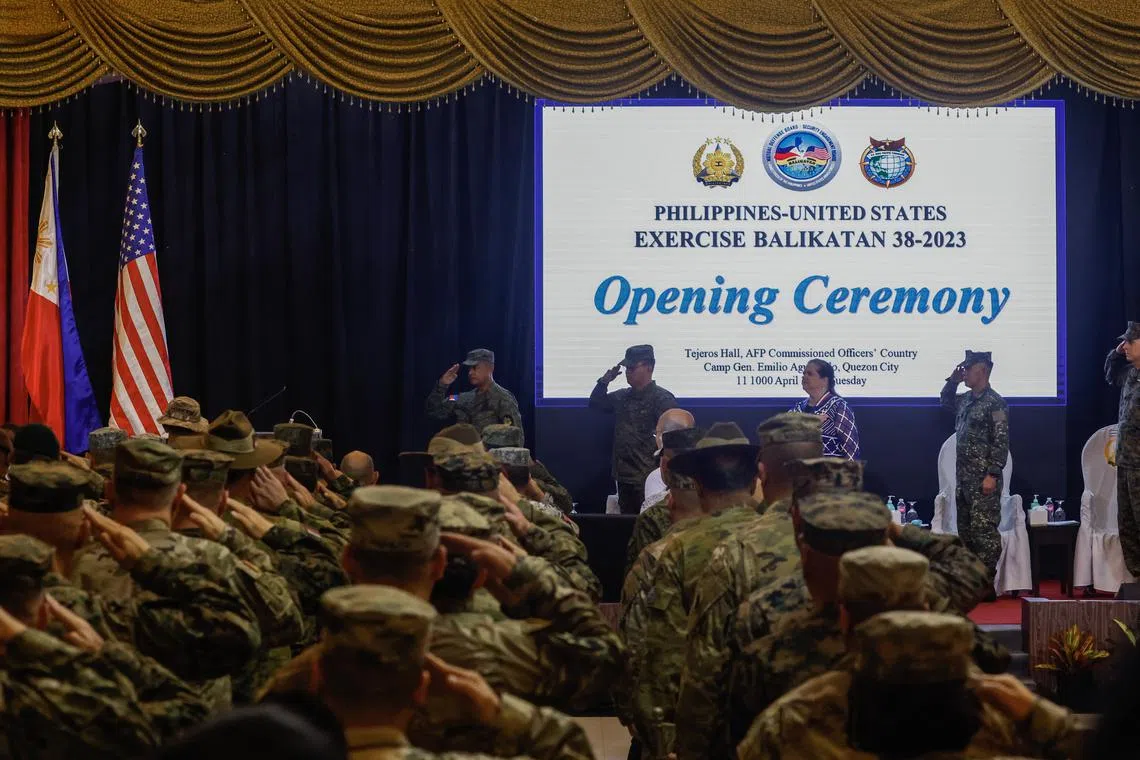‘We are combat-ready’: Philippines, US kick off largest war games amid soaring China tensions
Sign up now: Get insights on Asia's fast-moving developments

Key military officials from the Philippines and the United States at the opening ceremony for the 38th Exercise Balikatan at the Armed Forces of the Philippines (AFP) headquarters in Manila.
PHOTO: EPA-EFE
Follow topic:
MANILA – The Philippines and the United States on Tuesday launched their biggest-ever joint military exercise, which will include a ship-sinking rocket bombardment drill in the South China Sea, as tensions flare over Beijing’s rising military aggression in the region.
Key military officials from the two nations were present at the opening ceremony for the 38th Exercise Balikatan
Balikatan means “shoulder-to-shoulder” in Tagalog. The war games
Officials said a major highlight of the military exercise is the live-fire drills at sea to be held on April 26, about 12 nautical miles from the coast of Zambales, a province located near the South China Sea, waters in which Beijing and Manila have competing claims.
A decommissioned Philippine Navy ship will be bombarded with rockets and missiles by both the US and the Philippines to demonstrate the long-time allies’ maritime defence capabilities.
“It demonstrates that we are competent in employing combined arms and joint capabilities. We are demonstrating that we are combat-ready. We have the capacity to fire on a target from the land, from the air and from the sea,” said Colonel Michael Logico, AFP spokesman for Balikatan.
He added that Philippine President Ferdinand Marcos Jr will observe the live demonstration and that he was excited to watch the two forces in action.
The annual war games will be held in key areas in the Philippines, including some provinces such as Zambales and Palawan, whose coastlines are just hundreds of kilometres away from the South China Sea and Taiwan.
Balikatan will involve more than 17,600 soldiers – 12,200 from the US and 5,400 from the Philippines – making it the biggest iteration of the war games thus far, at a time when China is ramping up its military activities in the region.
Australia is also deploying more than 100 soldiers for Balikatan, while allied countries such as Japan, India, Canada and Britain are sending military observers.
The Philippine Coast Guard continues to monitor scores of suspected Chinese militia ships in the eastern parts of the South China Sea that lie within Manila’s exclusive economic zone.
The country calls this area the West Philippine Sea.
The heightened surveillance comes as eight Chinese navy ships maintain a presence in waters around Taiwan, despite the end of three-day-long war games held by China in the wake of a meeting last week between Taiwanese President Tsai Ing-wen and US House Speaker Kevin McCarthy in California.
Experts have said that because of its geographical location, the Philippines is at risk of being caught in the crossfire should tensions escalate over Taiwan.
While Philippine and US defence officials have said the Balikatan exercise is not meant to target any specific country, maritime defence expert Greg Poling told The Straits Times that it sends a clear message to Beijing.
“Saying that a centrepiece of Balikatan from here on out is going to be the Philippines and the US practising shooting old ships from shore is a pretty clear message that the two countries are focused on asymmetric capabilities, with land-based fire as a core component of the alliance,” said Mr Poling, who heads the South-east Asia programme at the Centre for Strategic and International Studies in Washington.
“It’s exceedingly obvious what this training is for: It’s for a singular mission – deterring Chinese aggression around the Second Thomas Shoal and in the South China Sea more broadly,” he added.
The Philippines and the US are long-time allies, but relations soured under former president Rodrigo Duterte, who turned his back on Washington in favour of getting loans and grants from Beijing.
But Mr Duterte’s successor, Mr Marcos, and US President Joe Biden have since sought a fresh start in their relations, boosting existing defence and security deals in a bid to counter China’s growing influence in the Indo-Pacific.
In February, the two nations agreed to expand the 2014 Enhanced Defence Cooperation Agreement (Edca) by increasing to nine the total number of military bases where American forces can construct facilities,
Of the four new sites named under the Edca, three are in the northern provinces of Cagayan and Isabela, which are located about 580km and 820km from Taiwan, respectively. The fourth new Edca location is in Palawan, an island province close to the disputed Spratly archipelago in the South China Sea.


